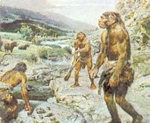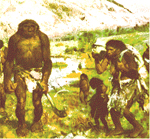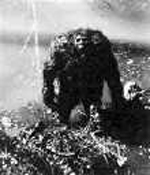
The Chuchunaa which are sometimes referred to as the "Siberian Snowman" or “Tjutjuna“, are unique among their kind for numerous reasons not the least of which being their purported penchant for appearing before eyewitnesses clothed in animal skins. Their name translates to (outcasts or fugitives) which many of the eyewitnesses declared them. This fact that the Chuchunaa are said to wear animal skins has led some researchers to believe that these creatures may have less in common with Gigantopithecus-like creatures such as BIGFOOT or the YETI, and may possibly be a part of what some have speculated are a relic population of paleo-asiatic aborigines or possibly even Neanderthals.
The Chuchunaa has been described by most eyewitnesses as being a tall (6-7FT) and human-like, with broad shoulders, a large protruding brow, long, matted hair and occasionally bearing unusual fur coloration. In fact, LOREN COLEMAN who is a well known cryptozoologist reported in his book: ?Crypto-zoology: A to Z?, that at least one member of this species was given a name by nearby natives. They called him Mecheny (which translates from the native Mnasi dialect as The Marked One) due to the fact that this creature allegedly bore a distinctive patch of white hair on its forearm.  Although reports of these creatures were first brought to the attention of the academic world in 1928, when the Soviet government sent expeditions into the upper regions of the Indigirka and Yana rivers in order to collect accounts of these unique man-beasts, most reports of these creatures hail from native nomadic tribes such as the Yakuts and the Tungus. The tales and reports from the Yakuts and Tungus tribes date much further back in time then 1928, much like the Native Americans have reports of Bigfoot or as they say “sasquatch.”
Although reports of these creatures were first brought to the attention of the academic world in 1928, when the Soviet government sent expeditions into the upper regions of the Indigirka and Yana rivers in order to collect accounts of these unique man-beasts, most reports of these creatures hail from native nomadic tribes such as the Yakuts and the Tungus. The tales and reports from the Yakuts and Tungus tribes date much further back in time then 1928, much like the Native Americans have reports of Bigfoot or as they say “sasquatch.”
Strangely, these same creatures are also found in the southeastern portion of Siberia. Here they are simply referred to as Mulen, which is the Tungus word for bandit. This name no doubt stems from the fact that these creatures are notorious for their midnight raids on barns and other dwellings. It appears the creatures are the same thing, just in different regions. There are also reports that these creatures have, on occasion, taken to eating human flesh - a trait which is not apparent in its Siberian cousin the ALMASTI.
In 1933, Professor P. Dravert became incensed when he heard reports that these creatures were being hunted, and petitioned the Soviet government to put an end to this heinous act, stating that Chuchunaa were also citizens of the Soviet Union, and therefore deserved equal protection under the law. Obviously the Soviet government at the time had no interest in such things. His plea went unheeded.  By the 1970s however, times were different, even in the midst of a cold war. Geologist Vladimir Pushkarev conducted research throughout Siberia. He also heard native accounts of these native creatures, but - due in part, no doubt, to the overwhelming encroachment civilization - he concluded their numbers had dwindled since the dawn of the 20th century.
By the 1970s however, times were different, even in the midst of a cold war. Geologist Vladimir Pushkarev conducted research throughout Siberia. He also heard native accounts of these native creatures, but - due in part, no doubt, to the overwhelming encroachment civilization - he concluded their numbers had dwindled since the dawn of the 20th century.
Despite this, in 1985, British anthropologist Myra Shackley claims to have seen the Chuchunaa known as "Mecheny" with her own eyes.
Most investigators have concluded that these hominids - which may be one of the last living links that the human race has with its simian ancestors - are either extinct or dangerously close to being wiped off the face of the Earth. The remote stretches of Siberia are still to this day some of the most barren areas of our planet. It would be freezable that the Chuchunaa may still exist, and recent communication with locals may suggest that is a fact.
Yakutia, one of the leading newspapers in the Republic of Sakha (Yakutia) published in May 2004 an article 1) concerning nature and its protection in Yakutia. It had the following paragraph:
“The Screaming of Sendushnyj.
Mount Kuorat-Khaja lied opposite the fishing village of Chekurovka 2) . On a dangerous steep slope lied the ruins of an aeroplane. Some old people claimed that in 1957 hunters from the surrounding villages killed a Chuchunaa, the snowman. It is said that its body was brought on the Lena river to Yakutsk [capital of Yakutia] and disappeared there. The legend has it that Chuchunaa lived in the mountains of Verchojansk. It caught reindeers, the skins of which it wore. It is further said that upon meeting people, the snowman would scream quite terribly. In the Tundra, this snowman was named Sendushnyj, after ‘sendukha’, an old name of Tundra. Although this legend defeated any commonsense, it refused to die. On the other side of the mountain range, in the areas of Najba 3), some reported of a highly discreet creature that was called Ikki-Mterlljakh, literally meaning ‘two meters tall’. It is claimed that those who were hunting, fishing and/or collecting firewood along the riverbank saw the snowman. It is also reported that as dawn set in, he would enter the village."
There are also other modern day reports of the Chuchunaa.
The Russian newspaper Yakutsk Vechernij (Evening Yakutsk) reported in December 2002 with the title In search of the Snowman 1 about the journey of two reporters on the track of a strange animal. The journey was inspired by an article 2 in the 29th March edition of the same newspaper.
In a village in the Verkhoyansk region, Barylas district, an unknown animal had been caught in a wolf-trap in the middle of March 2002. It was already dead when discovered and described "like a primate" about the size like a large dog. The whole body, apart from feet and face, was covered in fur. It had a long tail. There are three versions about what happened with the corpse: The teacher Jakob Potapov from the neighboring settlement Borulakh said that the body had been taken to the capital Yakutsk. Someone else claimed that the animal had been torn to pieces by dogs and the third version was that "frightened people" had buried the corpse together with the trap.
The chief ot the Sartan town concil, Sergej Slepzov, talked about another similar case half a year earlier. A young man, Albert Slepzov, had found by coincidence a dead unknown animal which was similar to an ape. In this connection it was suggested that it could be a Chuchunaa 3 as the 'wildman' are known in the region. Older local people who had seen the dead animal called it Aabasi kiila 4.  The reporter Elena Tikhonova and the photographer Michael Kotschetov contacted the relatives of Albert Slepzov in the settlement Badagaj. These confirmed that Slepzov had found a strange animal but were unable to say what happened with the corpse. However, according to the council workers of the Verkhoyansk region, Albert Slepzov´s father had buried the body. On hearing this the reporters started out from the capital Yakutsk to find Albert Slepzov in the Verkhoyansk region. After two hours flying time and twelve hour car driving on dirt tracks they arrived in the village Junkur where Albert Slepzov was supposed to be but wasn´t.
The reporter Elena Tikhonova and the photographer Michael Kotschetov contacted the relatives of Albert Slepzov in the settlement Badagaj. These confirmed that Slepzov had found a strange animal but were unable to say what happened with the corpse. However, according to the council workers of the Verkhoyansk region, Albert Slepzov´s father had buried the body. On hearing this the reporters started out from the capital Yakutsk to find Albert Slepzov in the Verkhoyansk region. After two hours flying time and twelve hour car driving on dirt tracks they arrived in the village Junkur where Albert Slepzov was supposed to be but wasn´t.
After various difficulties had been overcome, they were able to find the eyewitness's 64 year old father, Afanasi Slepzov, in another place. He reported that his son had found an unknown animal with a long tail in a trap at the end of the October 2001. The color of the coat was an unusual yellow. The boy was afraid and left the animal behind in the wilderness. Back at home he made a sketch of his find. After a few days Afanasi Slepzov tried to find the animal with a companion but, according to him, unsuccessfully due to new snowfall.
The reporters confronted Slepzov with the statements of other people in the village that in reality he had found the animal and had hidden it. Slepzov denied this. The questioning was not continued as it was obvious that the subject made him uncomfortable. According to statements of other village residents, Slepzov had initially kept his sons discovery secret and had first begun to talk about it when rumors were already circulating in the village. It was not possible for the reporters to visit the scene of the second finding in March 2002. Some time later a Moscow travel agency offered to finance another expedition.
The place where this happened lies on the arctic circle in the autonomous Republic of Sakha (Yakutia), eastern Siberia, with the capital Yakutsk about 200 kilometers east of the main ridge of the Verkhoyansk mountains. This area is one of the coldest on Earth where the winter temperature can fall to minus 70°C. It is possible to reach many settlements only by air or over roads which are passable only at certain times of the year. This makes the Chuchunaa one of the most difficult cryptids in the world to reach.
The Evidence
No physical evidence of the Chuchunaa has been brought forward to modern society. There are specific accounts of sightings which resulted in the beast being killed however no physical evidence has been able to support these claims. Evidence does however exist in the form of a photograph that can not be documented or dated. That photograph is found in our gallery.
The Sightings
• There were tales of a strange being wandering the remote forests of Tunguska near the scenes of devastation. The nomadic reindeer herdsmen of Siberia sighted the gigantic grey humanoid figure some 50 miles north of the Chunya river. They saw the man, who seemed to be over 8 feet in height, picking berries and drinking water from a stream. The superstitious Mongol herdsmen regarded the freakish-looking stranger as one of the fabled Chuchunaa. Others who supposedly investigated one of man kinds greatest mysteries "the Tunguska blast" have also claimed to have seen the Chuchunaa.
• Previous to 1928 both sightings and stories regarding the Chuchunaa were not common play but certainly widespread enough to be passed down through time and have the stories make their way into modern cities.
• In 1928, the Soviet government sent expeditions into the upper regions of the Indigirka and Yana rivers in order to collect accounts of these unique man-beasts. They documented a handful of sightings.
• Some old people claimed that in 1957 hunters from the surrounding villages killed a Chuchunaa, the snowman. It is said that its body was brought on the Lena river to Yakutsk [capital of Yakutia] and disappeared there.
• Many claim the last "reliable sightings" of the Chuchunaa came out of Siberia in the 1950s. Many speculate the sightings slowed because the grasp the Soviet Union had on the entire region during the cold war.
• Afanasi Slepzov reported that in October 2001 his son had seen an unusual animal with a yellow colored coat. It was described as a primate. The relationship between Afanasi and Albert Slepzov has not been confirmed but the stories seem to line up as father and son.
• In 2001 Albert Slepzov, had found by coincidence a dead unknown animal which was similar to an ape. In this connection it was suggested that it could be a Chuchunaa 3 as the 'wildman' are known in the region. He would not state what became of the body.
• In a village in the Verkhoyansk region, Barylas district, an unknown animal had been caught in a wolf-trap in the middle of March 2002. It was desribed just as most of the Chuchunaa descriptions are. The body vanished one way or another. The story is above.
The Stats – (Where applicable)
• Classification: Primate or Neanderthal Man
• Size: 6 to 7 feet tall
• Weight: Heavy set body, probably 400-600lbs.
• Diet: Reports indicate these creatures are pillagers and eat as humans would
• Location: Siberia, Russia
• Movement: Walking
• Environment: Mountains, snow plains, siberian forests
|